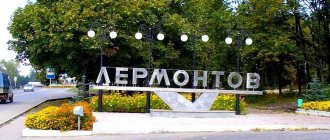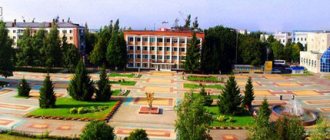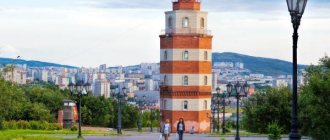This term has other meanings, see Korkino (meanings).
| City | |
| Korkino | |
| Flag | Coat of arms |
Moscow
Chelyabinsk
Korkino
Korkino
Media files on Wikimedia CommonsKorkino
- a city in the Chelyabinsk region of Russia, the administrative center of the Korkinsky district. A municipality within the Greater Chelyabinsk agglomeration. The city is located in the Southern Urals, 35 km from Chelyabinsk.
The city has a railway station of the same name on a branch from the Chelyabinsk - Troitsk line of the South Ural Railway[2].
Content
- 1. History
- 2 Population
- 3 Economics
- 4 Environmental situation
- 5 Transport
- 6 Enterprises and organizations
- 7 Educational institutions 7.1 Higher
- 7.2 Secondary special
- 7.3 Schools
History[ | ]
As a settlement, Korkino arose in the middle of the 18th century. It was a small village located 14 versts from the Etkul fortress, on the busy steppe road from the Chelyabinsk fortress to Orenburg and the Verkh-Yaitsk fortress, on the Chumlyak river. According to one version, the name of the village included the surname of four Korkin brothers, state peasants, natives of the village of Korotkova in the city of Shadrinsk, who wished to perform Cossack service in the Chelyabinsk fortress in 1736. However, another version of the origin of the settlement became more widespread. According to legend, Korkino was founded in 1746 by the escaped convict Afanasy Korkin, a Cheremis by nationality, who practically did not know the Russian language. Having married the young widow Martha, Afanasy built houses on the banks of the Chumlyak River away from prying eyes. Soon, Martha’s relatives from the Etkul fortress began to move in with the Korkins, and the village gradually turned into a small village.
How to get to the Korkinsky quarry?
The city of Korkino is located 35 kilometers south of Chelyabinsk. By car you need to go along the Trinity Highway. Follow the sign for Korkino and turn to the interchange. Next, follow the main road – along the street. 30 years of the Komsomol. After driving through the city (you can see a few city attractions along the way), you will arrive in the village of Rosa. Turning left takes you to an observation deck near the former Rosa station. GPS coordinates of the observation deck: N 54º 54.717´; E 61º 26.744´.
By public transport, you can get to Korkino by bus from Chelyabinsk. It is better to go to the quarry in windy and sunny weather.
A visit to the Korkinsky quarry can be combined with an acquaintance with the sights of the city of Chelyabinsk.
Pavel Raspopov
See also:
- Coal of the Western Urals. History of discovery and development
- The city of Kopeysk: history and attractions
- Uchalinsky quarry
Population[ | ]
| Population | ||||||||
| 1939[3] | 1959[4] | 1967[3] | 1970[5] | 1979[6] | 1989[7] | 1992[3] | 1996[3] | 1998[3] |
| 11 600 | ↗84 962 | ↘83 000 | ↘70 890 | ↘63 253 | ↘45 198 | ↘44 500 | ↘41 600 | ↗41 900 |
| 2002[8] | 2003[3] | 2005[3] | 2006[3] | 2007[3] | 2008[9] | 2009[10] | 2010[11] | 2011[12] |
| ↘41 501 | ↘41 500 | ↘39 900 | ↘39 400 | ↘38 900 | ↗40 266 | ↘38 076 | ↗38 597 | ↘38 499 |
| 2012[13] | 2013[14] | 2014[15] | 2015[16] | 2016[17] | 2017[18] | 2018[19] | 2019[20] | 2020[1] |
| ↘38 033 | ↘37 333 | ↘36 219 | ↘35 516 | ↘35 186 | ↘34 967 | ↘34 672 | ↘34 166 | ↘34 014 |
As of January 1, 2021, in terms of population, the city was in 458th place out of 1,116[21]cities of the Russian Federation[22].
Economics[ | ]
Coal mining (discontinued since 2017), confectionery factory, glass factory, reinforced concrete products factory, excavator and carriage repair plant, dairy factory (closed in 2007). In 2009, the largest enterprise in the Urals Federal District for the production of corrugated cardboard and corrugated packaging, LLC YuzhUralCarton Factory, was opened. In 2012, construction began on a plant for crane parts in the area of the village of Keramikov and a foundry in the Severo-Zapadny microdistrict, between Timofeevka and the dump of the Korkinsky open-pit mine. But in 2021, they began to close the old plant near the mine. Example reason: “Cleaning the city from factory waste.”
There is a coal mine near the city. For 2021, its depth is 493 m. [ source not specified 169 days
] The Korkinskoye coal deposit was discovered in the spring of 1931. Already in August, drillers stumbled upon a layer with a thickness of 100 meters, and a little later - 200 meters. At that time, coal seams of such thickness were not known. The mine took several years to build. Stripping work was carried out manually, with the help of axes, and later they began to use explosions. The famous “Korkinsky explosion”, which was prepared for more than six months and was accompanied by the evacuation of the city, went down in history. On July 16, 1936, at exactly 10 o'clock Moscow time, an explosion was carried out. The mass of raised soil reached a height of more than half a kilometer, the explosion ejected about a million cubic meters of earth, and the explosion itself was recorded by all seismic stations in the world. The rock dumps from the open-pit mine occupy a huge area and stretch along the A310 highway for more than 1 km.
Small business in the city is represented by a network of small enterprises (376) and individual entrepreneurs (more than 2,500). Their turnover in 2007 amounted to more than 935.9 million rubles. The share of small businesses in the total volume of shipped products is 17%.
Church of the Holy Apostles Peter and Paul
Now let’s make a short retreat from the city center and go to the oldest building in Korkino. The map showed us only 10 minutes of walking in a straight line through the private sector.
The Church of the Holy Apostles Peter and Paul was built in 1888, according to one version by Italian, according to another - by Finnish masters. This is the only pre-revolutionary building that has survived in Korkino to this day. It is also the second most important attraction of Korkino.
Church of the Holy Apostles Peter and Paul in Korkino
The church was saved from complete destruction during Soviet times by its location on the outskirts of the city. The church was closed, the domes were removed and the bell tower was destroyed. The remaining structure alternately housed a store, a dormitory, warehouses and a blacksmith shop.
In 1942, the church was reopened; repairs were made by parishioners.
Church of the Holy Apostles Peter and Paul in Korkino
The most amazing relic of the temple is the icon of the Savior Not Made by Hands , which was given to the Korkin residents from the Holy Dormition Pochaev Lavra of Ukraine. The look of Christ on the icon is a mystery! There is still debate about whether his eyes are closed or not.
Nearby you can see another relic - the icon of St. Seraphim of Sarov , brought from the city of Troitsk, Chelyabinsk region. The icon is all hung with decorations - these are gifts from grateful parishioners for the miracles that happened in their lives.
Icons in the Orthodox Church of Korkino
On the way back through the private sector we look at old wooden houses. Perhaps some of them have been here since the founding of the city.
But in general, as elsewhere in our country, the private sector is motley and unsightly thanks to ridiculous self-construction and thoughtless alterations. For example, how could such a thing be built?
Ecological situation[ | ]
Due to the fact that Korkino is an industrial city with a large number of factories, the environmental situation in the city is especially acute. The city's air is of poor quality. The city is unfavorable for living due to air pollution. Until 2021, during calm periods the city was covered with a gas cap emitted by the coal mine; at the end of 2021, the situation improved; according to the official version, the mine stopped producing gas. Residents of the city are concerned about possible environmental pollution after the Tominsky mining and processing plant reaches full capacity. To fully understand the environmental situation, it is necessary to take into account the proximity of the city of Korkino to the city of Chelyabinsk (45 km).
Korkino
(Chelyabinsk region)
OKATO code:
75431
Founded: Urban settlement since:
1932
City since:
1942 City of district subordination (Korkinsky district, Chelyabinsk region)
Center:
Korkinsky district
Telephone code (reference phone)
| 35152***** | 22-2-25 |
Deviation from Moscow time, hours:
2
Geographic latitude:
54°53′
Geographic longitude:
61°24′
Altitude above sea level, meters:
230 Sunrise and sunset times in the city of Korkino
Transport[ | ]
Industrial electric locomotive PE2m-241 at the Korkino depot.
The Korkino railway station is located in the city. The station has a railway station, previously there was a Korkino - Chelyabinsk train, electric freight trains also ran to the Korkinsky coal mine, in 2013 the contact network was dismantled, but the tracks have not yet been dismantled, if necessary, diesel locomotives transport coal along them, and freight trains also travel to Dubrovka [ specify
].
The A310 highway (formerly M36) runs near Korkino. The main transport in Korkino are buses and fixed-route taxis, with this transport you can get to anywhere in the city for a price of 23 rubles (beginning of 2021), the main carriers are Korkino ATP LLC, Favorit LLC. There is also a taxi, travel on this transport around the city is 60 rubles - (April 2019), it was 50 rubles - (January 2010), there are many carriers.
The city has a cable car to the coal mine (for workers). Helicopter tours are also available to get a bird's eye view of the coal mine.
Lenin Street
We start our walk around Korkino from Lenin Street, or rather from the bus station. We arrived in the city from Chelyabinsk on the morning bus. Travel time is exactly an hour, ticket price is 100 rubles.
This is what our bus looked like. It’s very nice that it’s not a minibus, even though there were few passengers.
Bus Chelyabinsk-Korkino
The bus station looks very conventional - it’s just a stop with a bus schedule and a room with ticket offices.
Ticket offices in Korkino
By the way, until the mid-90s you could get from Chelyabinsk to Korkino by train. There are two railway lines leading to Korkino at once, and both of them were passenger lines. Behind this brick two-story building is the Korkino railway station, now a freight station.
Bus station in Korkino
Getting off the bus, we immediately see the first attraction of Korkino - a monument to miners, miners and builders of the city of Korkino . It was installed in 1984 to mark the 50th anniversary of the coal mine.
Monument to miners, miners and builders of Korkino
Lenin Street near the station, like a gate to the city, welcomes guests with ceremonial “Stalin” cars. Of course, the houses are as “ceremonial” as a small provincial town in the Urals could afford: minimal decor, no columns and no belvederes.
Houses on Lenin Street in Korkino
Walking a little forward, it turned out that the rest of Lenin Street was built up with brick Khrushchev buildings. All houses are no higher than 5 floors and were built between 1957 and 1968.
Houses on Lenin Street in Korkino
In the center of Lenin Street there is a shady boulevard - one of the legacies of the Soviet Union. In large cities, such boulevards are leveled with asphalt to widen the roadway. And in small towns there is no need to mindlessly cut down trees.
Boulevard on Lenin Street in Korkino
New stops:
But no miracles happened with transport; minibuses travel around the city.
Public transport in Korkino
In the very center of the city they sell milk from a barrel. In the summer, they probably bottle kvass nearby.









